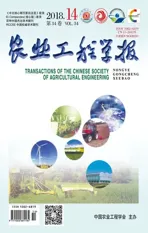基于改进SWAT模型的南方多水源灌区灌溉用水量模拟分析
2018-08-10崔远来王士武温进化王贺龙
崔远来,吴 迪,王士武,温进化,王贺龙
基于改进SWAT模型的南方多水源灌区灌溉用水量模拟分析
崔远来1,吴 迪1,王士武2,温进化2,王贺龙2
(1. 武汉大学水资源与水电工程科学国家重点实验室,武汉 430072;2. 浙江省水利河口研究院,杭州 310020)
为提出一种合理有效的南方多水源灌区灌溉用水量模拟统计方法,该文针对南方多水源灌区水循环及灌溉取水特点对SWAT模型进行改进,尤其添加了多水源自动灌溉模块用于模拟作物不同水源类型的灌水量,并统计推求灌区灌溉用水量。以浙江省浦江县通济桥水库灌区为例,应用改进SWAT构建灌区水循环模型,利用灌区出口实测月径流数据及4条干渠渠首监测的灌水量数据校正及验证模型,其中月径流在验证期的Nash-Suttclife效率系数为0.89,干渠灌溉用水量模拟值与观测值相对误差的绝对值最大不超过20%,表明改进SWAT模型具有良好的模拟效果。利用所建模型模拟分析通济桥水库灌区长系列灌溉用水量,结果显示灌区灌溉用水量呈现丰水年小、干旱年大的变化规律;除监测的骨干水源通济桥水库及浦阳江取水以外,灌溉用水量的41.40%来源于灌区内部的河道、塘堰及小型水库,说明只监测干渠渠首灌水量无法统计整个灌区灌溉用水量;随着灌区节水改造投入,灌区灌溉水利用系数提高,其灌溉用水量减少。基于改进SWAT模型进行多水源灌区灌溉用水量模拟为灌区灌溉用水量统计分析提供了一种有效的方法。
灌溉;模型;水库;多水源灌区;改进SWAT;不同水源类型
0 引 言
为提升中国水资源公报质量和支撑最严格水资源管理制度考核工作,落实最严格水资源管理制度,开展水资源监控及用水总量统计十分必要。在中国,农业用水量占总用水量的60%以上,其中,灌溉用水占农业用水量的90%以上,是用水总量统计的重点。农业用水指农田灌溉用水、林果地灌溉用水、草地灌溉用水、渔塘补水和畜禽用水,其中灌溉用水量是指从各类水源取来用于灌区作物灌溉的水量之和。中国南方多水源灌区中存在多种水源,不同水源之间存在不同程度的互联互通,属于库、塘、渠结合的“长藤结瓜”灌溉系统[1-2]。由于水源种类多、分布复杂、取水的随机性强、且存在重复利用,有时难以有效区分不同水源的灌水量,水量计量工作不仅量大,且存在相当难度,并且只计量灌区渠首的取水量也不能代表整个灌区的灌溉用水量[3]。此外,灌区各个分区之间的土地利用、水源类型等存在差异性,采用典型调查或现行灌溉定额与实际灌溉面积数据进行框算得到的灌溉用水量精度需要进一步提高[4]。因此,寻求一种合理有效的灌溉用水量模拟统计方法十分必要。推求灌溉用水量的基础是水量平衡原理[5],鉴于多水源灌区的空间异质性,分布式水文模型是获得水量平衡要素的一个有效工具。其中,SWAT(soil and water assessment tool)模型是一个具有物理基础的分布式水文模型,具有自动灌溉模块可用于推求作物灌溉用水量[6-8]。其不仅能够模拟日、月、年尺度流域水循环过程,还可用于人类活动对水循环影响的分析研究,在灌区水循环等方面已有诸多应用[9-14]。
SWAT模型是适用于自然流域的分布式水文模型[7]。然而,灌区水文循环过程相对于自然流域更加复杂多变,不仅受自然流域水平衡要素的影响,而且受人类活动的影响[15-16]。因此,为更好地将SWAT模型应用于灌区水循环过程的模拟,国内外不少学者对其进行了改进。代俊峰等[17]针对中国南方丘陵水稻灌区的水文特点,改进SWAT模型的灌溉水分运动模块、稻田水分循环模块、稻田水量平衡各要素以及产量模拟的计算方法,增加了渠系渗漏模拟模块及其对地下水的补给作用、塘堰的灌溉模块等,并将其应用于灌区水管理研究[18];陈强等[19]将PSO算法代替SWAT模型原有的SCE自动率定算法,构建新的SWAT模型参数自动率定模块,并将水资源配置模型的农业灌溉用水输入到改进后的SWAT模型中,实现2个模型的松散耦合;Xie等[20]在稻田蒸发蒸腾、控制灌溉排水、塘堰实时灌溉等方面对SWAT模型进行了改进;此外,还有其他学者对SWAT模型也做了相应的改进[21-26]。然而,上述改进中均未涉及作物的多种水源联合灌溉,同时,由于水源选择单一,SWAT模型未能模拟作物的多水源灌溉。
综上,本文以SWAT模型为基础工具,针对南方多水源灌区水文循环及作物灌溉特点,整合代俊峰等[17]及Xie等[20]对SWAT模型稻田水循环模块的改进,同时提出一种多水源自动灌溉模块并将其添加到SWAT模型,从而得到适用于南方多水源灌区的改进SWAT模型。以浙江省浦江县通济桥水库灌区为例对改进SWAT模型进行率定及验证,利用改进SWAT模型模拟分析灌区不同水源的灌溉用水量及其变化规律,以期为灌区灌溉用水量模拟统计提供有效方法。
1 材料与方法
1.1 研究区概况
通济桥水库灌区位于浙江省浦江县南部浦阳江盆地。灌区的灌溉水源以通济桥水库、浦阳江为骨干水源,灌区内小型水库(金狮岭水库、里坞水库、岳塘水库)、塘堰及河流为辅,骨干水源以4条干渠贯穿整个灌区,构成典型的南方多水源“长藤结瓜”灌溉系统,如图1a所示。
由图1a所示,从北至南依次为北干渠、中干渠、南干渠72线、南干渠80线,其中南干渠72线的水源为浦阳江,其余3条水源为通济桥水库。由于通济桥水库灌区并非闭合流域,因此选择的建模区域较灌区范围稍大,所选区域的土地利用类型主要为林地、城镇、水稻田、葡萄地、水域及旱地,如图1b所示。灌区属亚热带季风气候,多年平均气温16.6 ℃,多年平均降雨量1 466 mm,年内降水分布不均,多年平均水面蒸发量907 mm。灌区主要种植水稻、小麦等粮食作物及葡萄、草莓等经济作物,其中水稻与葡萄为主要灌溉作物,水稻种植面积为1 693.33 hm2,葡萄种植面积为1 893.33 hm2,且每年的6-9月为灌溉季节。
1.2 SWAT模型改进
SWAT模型将研究区划分为多个子流域,进而将子流域划分为多个水文响应单元(HRU),以HRU为最小水文响应单元进行模拟。针对南方多水源灌区作物灌溉特点提出的多水源自动灌溉模块的结构如图2所示。
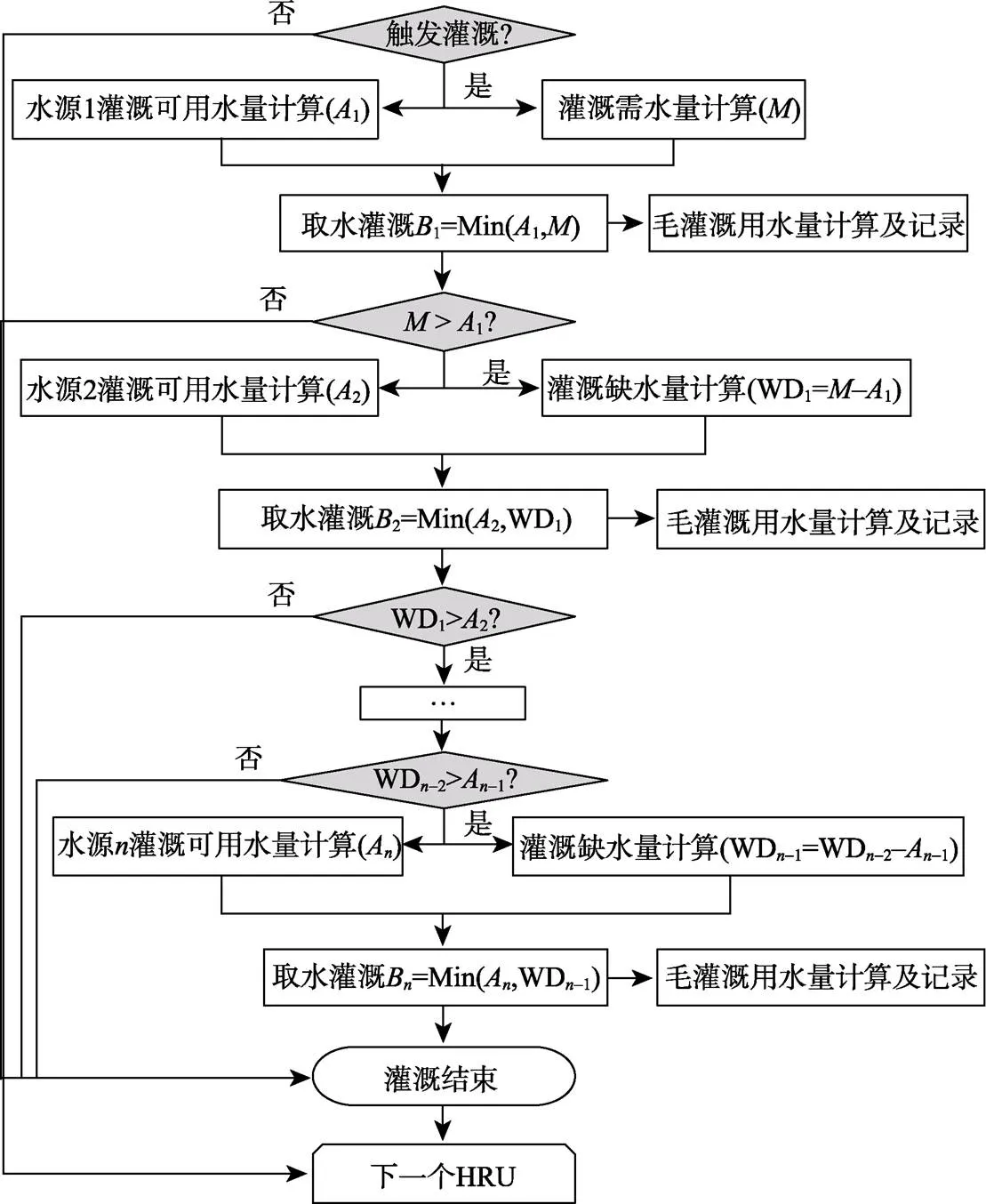
注:HRU为最小水文响应单元。
结合图2对多水源自动灌溉模块的说明如下:
1)原SWAT中灌溉用水量一般预先确定作为输入条件或利用单一水源的自动灌溉模拟[7],改进SWAT可以根据作物适宜田间土壤含水率或稻田水层深度控制标准,自动触发灌溉并确定每次田间净灌水量,同时从不同水源取水灌溉,从而在水循环模型中同步实现不同水源类型灌溉用水量的自动模拟。

3)图2中水源1、水源2等为HRU的灌溉水源及顺序,即在模型运行之前需要为HRU指定灌溉水源及顺序。以子流域为对象进行指定,同一子流域内HRU的灌溉水源及顺序一致。对于南方多水源灌区,每一个子流域可能存在的水源有子流域内部河道、塘堰、中小型水库、子流域外部河道及大型水库。通常设定第一水源为子流域内部河道,第二水源为子流域内部塘堰,并在SWAT模型软件界面上指定,而后面的中小型水库、子流域外部河道及大型水库则利用新增的输入文件进行指定。
4)水源灌溉可用水量是指可从水源取用的最大毛水量考虑灌溉水利用系数后折算成田间的净水量。对于不同类型的水源,由于水源之间存在差异其计算有所不同,具体如下:
对于河道

对于塘堰

对于水库

5)模拟多水源灌溉时,从第一个水源开始,取第一水源实际净灌水量为该水源灌溉可用水量与本次灌溉需水量的较小值,当第一水源实际净灌水量小于灌溉需水量则计算缺水量,如图2所示,继而下一个水源取水灌溉,直至灌溉满足要求或到最后一个水源。每个水源的实际净灌水量除以灌溉水利用系数得到该水源毛灌溉用水量(简称灌溉用水量)。
除多水源自动灌溉模块的添加外,针对“长藤结瓜”灌溉系统,对改进SWAT模型增加了骨干水源对灌区内部塘堰的补水功能,即灌溉季节若出现塘堰干涸情况,骨干水源将通过渠道对其进行补水,以此来反映农民干预调水的情况。此外,改进还包括稻田水平衡要素计算的改进及渠系水渗漏计算的添加等,具体内容见参考文献[17]和[20]。对于改进SWAT模型的使用,模型框架的搭建在SWAT软件界面上进行,与原模型基本一致,此外仅需创建文本文件输入水稻控制水深、灌溉水源及顺序等参数即可。
1.3 模型构建与校正及验证
1.3.1 研究区模型构建

1.3.2 模型校正及验证
模型构建之后需进一步对其进行校正及验证。参考前人研究中选择的径流敏感参数[27-29],结合研究区的特点选取参数,采用SWATCUP(SWAT Calibration and Uncertainty Programs)软件中的SUFI_2算法进行参数敏感性分析[30],从而选择10个参数作为径流的敏感参数。利用研究区出口(见图1a)1995-2007年的实测月径流数据对敏感参数进行率定从而校正径流模拟过程,经率定确定敏感参数的取值后,利用研究区出口2008-2015年的实测月径流数据对径流模拟过程进行验证,并选取相对误差(RE)、决定系数(2)和Nash-Suttclife效率系数(NS)来评估模型效率[31]。

2 结果与分析
2.1 径流校正及验证
经过反复调整后确定径流敏感参数取值,计算得到率定期径流的评价指标RE为11.83%、2为0.88以及NS为0.85,由此可知,通过参数率定,研究区出口径流量模拟结果与实测值吻合性较好。验证期径流的评价指标RE为9.05%、2为0.90以及NS为0.89,表明率定后的模型性能较为稳定。研究区出口径流模拟值与实测值的月际动态如图3所示,图3显示模型模拟的月径流过程与实测结果总体变化一致,说明模型适用于通济桥水库灌区的水量平衡模拟及分析。
2.2 灌溉用水量校正


表1 监测点灌溉用水量模拟值与观测值对比
2.3 不同水平年的灌溉用水量
利用改进SWAT模型模拟通济桥水库灌区1995—2017年的水循环过程,特别是其中的多水源自动灌溉模块模拟灌区水稻及葡萄的灌溉用水,基于灌区范围内子流域输出的灌溉模拟结果统计得到通济桥水库灌区不同水源类型的灌溉用水量,汇总得到整个灌区的灌溉用水量,其中不同水源类型包括子流域内部河道、塘堰、小型水库、浦阳江以及通济桥水库。将1995-2017年灌溉季节(6-9月)的降雨量进行排频,丰水年(25%)、平水年(50%)、干旱年(75%)以及特旱年(95%)的灌溉用水量模拟结果如图4所示。图4表明,灌区灌溉用水量基本呈现丰水年小、干旱年大的变化规律,分析其原因是丰水年降水较多,使得稻田和旱地出现缺水的情况较少,从而整个生育期内的灌溉需水量就较小,因此灌区丰水年的灌溉用水量较小,而干旱年则相反。但图中显示干旱年的灌溉用水量却大于特旱年,其主要原因是特旱年降雨量过少,导致河道及塘堰中蓄积的水量较少,也即无水可取,使子流域内部河道、塘堰以及浦阳江的灌水量偏少,因此其整体灌溉用水量会少于干旱年。从另一个角度分析,表明特旱年产生了水源缺水。
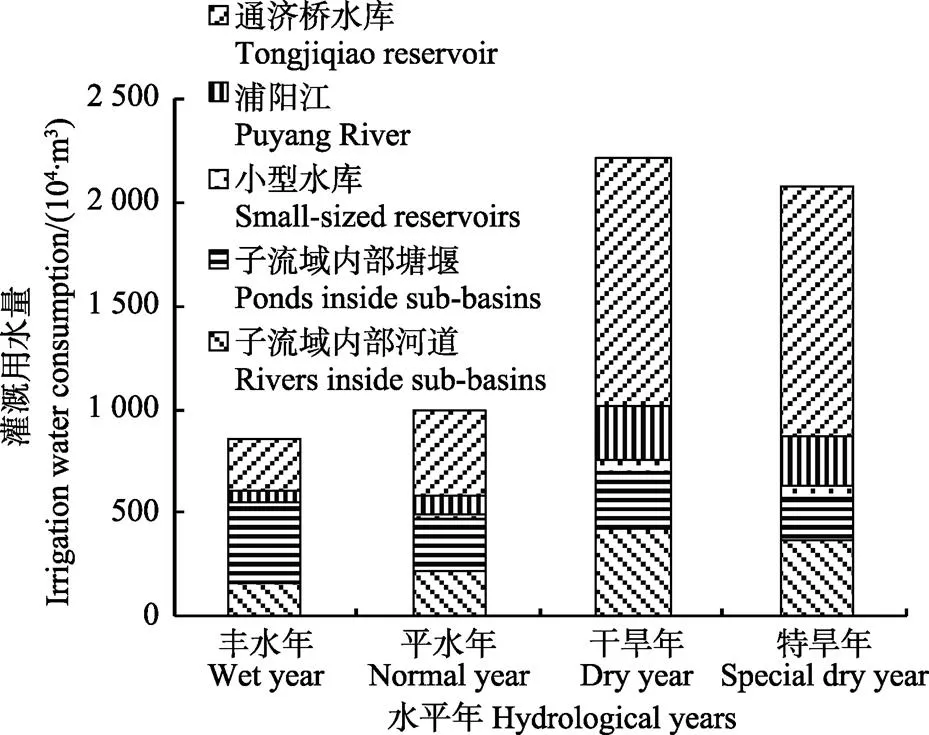
图4 不同水平年灌溉用水量模拟值
2.4 不同水源类型的灌溉用水量及供水比例
不同水源类型的灌溉供水比例是指各类水源用于作物灌溉的水量占总的灌溉用水量的百分比。利用模型模拟得到1995-2017年灌区不同水源类型的灌溉用水量及供水比例的多年平均值如表2所示。
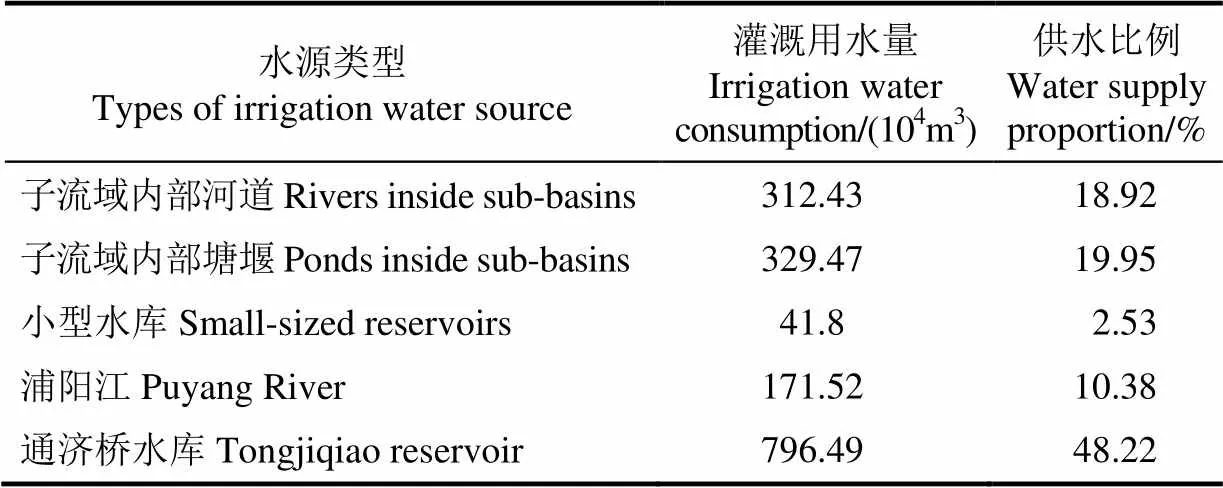
表2 不同水源类型灌溉用水量模拟值及供水比例的多年平均值
表2表明,通济桥水库灌区的作物灌溉主要由通济桥水库供水,其次是子流域内部塘堰、河道以及浦阳江,小型水库供水最少。除骨干水源通济桥水库及浦阳江以外,灌区灌溉用水有41.40%来源于灌区内部的河道、塘堰及小型水库,因此若采用渠首计量的措施统计灌区灌溉用水量,则会产生较大的误差,而其他水源供水由于点多量大且具有随机性,又不便于计量,给灌溉用水量统计带来困难。利用本文的改进SWAT模型则能模拟统计出灌区每一年不同水源类型的灌溉用水量,从而较为合理的推求出灌区总灌溉用水量。
2.5 节水改造对灌溉用水量的影响
对于灌区节水改造,其最终的表现形式体现为对灌溉水利用系数的影响,改进SWAT模型将灌溉水利用系数作为输入的变量,因此,通过变动灌溉水利用系数则可模拟节水改造对灌溉用水量的影响。通济桥水库灌区现状条件下的灌溉水利用系数为0.54,在此基础上增加0.05来模拟节水改造后的灌溉用水量,见表3。
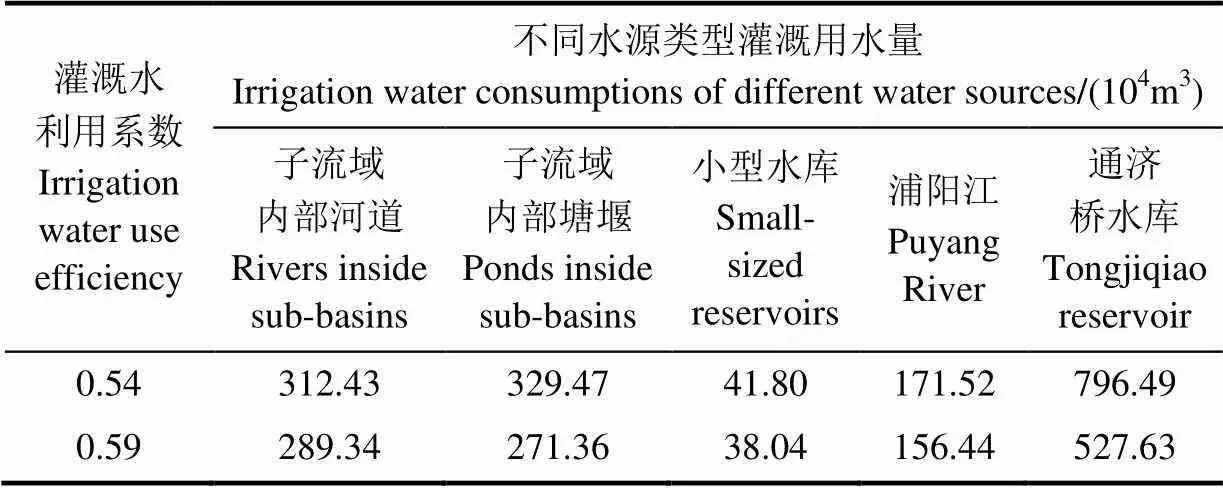
表3 多年平均情况下节水改造前后的灌溉用水量模拟值
表3表明,灌溉水利用系数增加0.05,通济桥水库灌区不同水源类型的灌溉用水量均减少,且主要体现在骨干水源通济桥水库的灌溉用水量减少,其主要原因是灌溉水利用系数提高后,骨干水源的输配水损失减少更多,其他水源由于输水线路短,减少幅度较少。
此外,对于水稻种植面积较多的灌区,除采取变动灌溉水利用系数的方法模拟不同节水情景的影响之外,改进SWAT模型还可输入水稻不同灌溉模式的3个控制水深[5],从而模拟采用水稻不同节水灌溉模式的影响,因此该模型可用于分析节水改造对灌溉用水量及灌区水循环的影响。
3 结 论
1)针对南方多水源灌区水循环及灌溉取水特点对SWAT模型进行改进,尤其添加了多水源自动灌溉模块用于模拟作物不同水源类型的灌水量。基于改进SWAT模型进行多水源灌区灌溉用水量模拟为灌区灌溉用水量统计分析提供了一种有效的方法。
2)改进SWAT模型构建的通济桥水库灌区水循环模型模拟的月径流与实测值比较,率定期及验证期的相对误差均低于12%、决定系数均≥0.88、纳什效率系数均≥0.85;4条干渠灌水量模拟值与观测值相对误差的绝对值最大不超过20%,校正时间段灌水量占全年灌水量比例模拟值与观测值的相对误差为7.64%,表明改进SWAT模型具有良好的模拟效果且可用于模拟灌区不同水源类型的灌水量。
3)模拟分析表明,通济桥水库灌区的灌溉用水量呈现丰水年小、干旱年大的变化规律;除监测的骨干水源通济桥水库及浦阳江以外,灌溉用水量41.40%来源于灌区内部的河道、塘堰及小型水库,说明只监测干渠渠首灌水量无法统计整个灌区灌溉用水量;此外,随着灌区节水改造投入,灌区灌溉水利用系数提高,其灌溉用水量减少。
相对于采用典型监测或现行灌溉定额与实际灌溉面积数据进行框算的方法,针对存在多种水源的灌区,利用分布式水文模型模拟统计灌溉用水量的方法更为准确有效。灌区分布式水文模型的研究处于起步阶段,如何将灌区自然特征与人类活动有效结合并使得模型更加适应于灌区特点需要进一步研究。本文所述改进SWAT模型中的多水源自动灌溉模块中仅考虑到多个地表水源的灌溉,故若用于地表水与地下水联合应用灌区,则需要进一步改进;并且在设定河道灌溉水可利用系数与塘堰死库容占比时,整个研究区采用相同的值,没有考虑灌区空间异质性对该值的影响。
[1] 郭元裕. 南方丘陵地区库、塘、渠网系统渠道设计流量的计算方法[J]. 水利学报,1965(4):62-66. Guo Yuanyu. Calculation method of channel design flow in reservoirs, ponds and canal network in hilly area in southern China[J]. Journal of Hydraulic Engineering, 1965(4): 62-66. (in Chinese with English abstract)
[2] 王士武,郑世宗. 南方多水源型灌区灌溉水利用系数确定方法研究[J]. 中国农村水利水电,2016(8):109-112. Wang Shiwu, Zheng Shizong. Study on determining method of irrigation water use efficiency in multiple water source irrigation area in South China[J]. China Rural Water and Hydropower, 2016(8): 109-112. (in Chinese with English abstract)
[3] 沈莹莹,吉晔,张绍强. 我国农业用水量统计工作面临的问题及建议[J]. 中国水利,2016(7):50-52. Shen Yingying, Ji Ye, Zhang Shaoqiang. Challenges faced by statistics of agricultural water use in China and advices[J]. China Water Resource, 2016(7): 50-52. (in Chinese with English abstract)
[4] 沈莹莹,张绍强,吉晔. 我国农业灌溉用水量统计方法的确定及工作开展情况[J]. 中国农村水利水电,2016(11):133-134. Shen Yingying, Zhang Shaoqiang, Ji Ye. The determination of the statistical methods for agricultural water use in China and its progressive situation[J]. China Rural Water and Hydropower, 2016(11): 133-134. (in Chinese with English abstract)
[5] 郭元裕. 农田水利学[M]. 第三版. 北京:中国水利水电出版社,2007.
[6] Arnold J G, Srinivasan R, Muttiah R S, et al. Large area hydrological modeling and assessment part I: Model development[J]. Journal of the American Water Resources Association, 1998, 34(1): 91-101.
[7] Neitsch S, Arnold J, Kiniry J, et al. Soil and water assessment tool theoretical documentation, version 2009[R]. Texas: Texas Water Resources Institute, 2011.
[8] 王中根,刘昌明,黄友波. SWAT模型的原理、结构及应用研究[J]. 地理科学进展,2003,22(1):79-86. Wang Zhonggen, Liu Changming, Huang Youbo. The theory of SWAT model and its application in Haihe Basin[J]. Progress in Geography, 2003, 22(1): 79-86. (in Chinese with English abstract)
[9] Ahmad K, Gassman P W, Kanwar R. Evaluation of the tile flow component of the SWAT model under different management systems[R]. Iowa: Center for Agricultural and Rural Development, 2002.
[10] Gosain A K, Rao S, Srinivasan R, et al. Return‐flow assessment for irrigation command in the Palleru river basin using SWAT model[J]. Hydrological Processes, 2005, 19(3): 673-682.
[11] 郑捷,李光永,韩振中,等. SWAT模型在水资源管理中研究进展与灌区应用展望[J]. 土壤,2009,41(5):689-695. Zheng Jie, Li Guangyong, Han Zhenzhong, et al. Advance of SWAT in regional water resource management and application prospect in irrigation district[J]. Soils, 2009, 41(5): 689-695. (in Chinese with English abstract)
[12] 李颖,王康,周祖昊. 基于SWAT模型的东北水稻灌区水文及面源污染过程模拟[J]. 农业工程学报,2014,30(7):42-53. Li Ying, Wang Kang, Zhou Zuhao. Simulation of drainage and agricultural non-point source pollutions transport processes in paddy irrigation district in North-East China using SWAT[J]. Transactions of the Chinese Society of Agricultural Engineering (Transactions of the CSAE), 2014, 30(7): 42-53. (in Chinese with English abstract)
[13] 樊庆锌,孟婷婷,李金梦,等. 江川灌区旱田改水田加剧水体氮磷污染[J]. 农业工程学报,2014,30(12):79-86. Fan Qingxin, Meng Tingting, Li Jinmeng, et al. Changing from dry field to paddy field intensifying water pollution by nitrogen and phosphorus loads in Jiangchuan irrigation area[J]. Transactions of the Chinese Society of Agricultural Engineering (Transactions of the CSAE), 2014, 30(12): 79-86. (in Chinese with English abstract)
[14] Ahmadzadeh H, Morid S, Delavar M, et al. Using the SWAT model to assess the impacts of changing irrigation from surface to pressurized systems on water productivity and water saving in the Zarrineh Rud catchment[J]. Agricultural Water Management, 2015, 175: 15-28.
[15] 王建鹏,崔远来. 水稻灌区水量转化模型及其模拟效率分析[J]. 农业工程学报,2011,27(1):22-28. Wang Jianpeng, Cui Yuanlai. Modified SWAT for rice-based irrigation system and its assessment [J]. Transactions of the Chinese Society of Agricultural Engineering (Transactions of the CSAE), 2011, 27(1): 22-28. (in Chinese with English abstract)
[16] 于颖多,焦平金,许迪,等. 排水循环灌溉驱动的稻区水循环模型与评价[J]. 农业工程学报,2016,32(11):138-143. Yu Yingduo, Jiao Pingjin, Xu Di, et al. Water cycle model and its assessment under cyclic irrigation of drainage water in paddy district[J]. Transactions of the Chinese Society of Agricultural Engineering (Transactions of the CSAE), 2016, 32(11): 138-143. (in Chinese with English abstract)
[17] 代俊峰,崔远来. 基于SWAT的灌区分布式水文模型:Ⅰ.模型构建的原理与方法[J]. 水利学报,2009,40(2):145-152. Dai Junfeng, Cui Yuanlai. Distributed hydrological model for irrigation area based on SWAT Ⅰ. Principle and method[J]. Journal of Hydraulic Engineering, 2009, 40(2): 145-152. (in Chinese with English abstract)
[18] 代俊峰,崔远来. 基于SWAT的灌区分布式水文模型:Ⅱ.模型应用[J]. 水利学报,2009,40(3):311-318. Dai Junfeng, Cui Yuanlai. Distributed hydrological model for irrigation area based on SWAT II. Model application[J]. Journal of Hydraulic Engineering, 2009, 40(3): 311-318. (in Chinese with English abstract)
[19] 陈强,秦大庸,苟思,等. SWAT模型与水资源配置模型的耦合研究[J]. 灌溉排水学报,2010,29(1):19-22. Chen Qiang, Qin Dayong, Gou Si, et al. Research of the coupling of SWAT model and water allocation model[J]. Journal of Irrigation and Drainage, 2010, 29(1): 19-22. (in Chinese with English abstract)
[20] Xie Xianhong, Cui Yuanlai. Development and test of SWAT for modeling hydrological processes in irrigation districts with paddy rice[J]. Journal of Hydrology, 2011, 396(1): 61-71.
[21] Kang M S, Park S W, Lee J J, et al. Applying SWAT for TMDL programs to a small watershed containing rice paddy fields[J]. Agricultural Water Management, 2006, 79(1): 72-92.
[22] 仕玉治,张弛,周惠成,等. SWAT模型在水稻灌区的改进及应用研究[J]. 水电能源科学,2010,28(7):24-28. Shi Yuzhi, Zhang Chi, Zhou Huicheng, et al. Development and application of SWAT model to paddy district in watershed scale[J]. Water Resources & Power, 2010, 28(7): 24-28. (in Chinese with English abstract)
[23] 郑捷,李光永,韩振中,等. 改进的SWAT模型在平原灌区的应用[J]. 水利学报,2011,42(1):88-97. Zheng Jie, Li Guangyong, Han Zhenzhong, et al. Application of modified SWAT model in plain irrigation district[J]. Journal of Hydraulic Engineering, 2011, 42(1): 88-97. (in Chinese with English abstract)
[24] Dechmi F, Burguete J, Skhiri A. SWAT application in intensive irrigation systems: Model modification, calibration and validation[J]. Journal of Hydrology, 2012, 470(14): 227-238.
[25] Sakaguchi A, Eguchi S, Kato T, et al. Development and evaluation of a paddy module for improving hydrological simulation in SWAT[J]. Agricultural Water Management, 2014, 137(5): 116-122.
[26] Chen Y, Marek G W, Marek T H, et al. Improving SWAT auto-irrigation functions for simulating agricultural irrigation management using long-term lysimeter field data[J]. Environmental Modelling & Software, 2018, 99: 25-38.
[27] 李硕,赖正清,王桥,等. 基于SWAT模型的平原河网区水文过程分布式模拟[J]. 农业工程学报,2013,29(6):106-112. Li Shuo, Lai Zhengqing, Wang Qiao, et al. Distributed simulation for hydrological process in Plain River network region using SWAT model[J]. Transactions of the Chinese Society of Agricultural Engineering (Transactions of the CSAE), 2013, 29(6): 106-112. (in Chinese with English abstract)
[28] 孙丽,陈曦炜,裴志远. 基于SWAT模型的清江流域中上游旱灾监测[J]. 农业工程学报,2014,30(21):129-137. Sun Li, Chen Xiwei, Pei Zhiyuan. Drought monitoring of upper and middle reaches of Qingjiang Basin based on SWAT model[J]. Transactions of the Chinese Society of Agricultural Engineering (Transactions of the CSAE), 2014, 30(21): 129-137. (in Chinese with English abstract)
[29] 程艳,敖天其,黎小东,等. 基于参数移植法的SWAT模型模拟嘉陵江无资料地区径流[J]. 农业工程学报,2016,32(13):81-86. Cheng Yan, Ao Tianqi, Li Xiaodong, et al. Runoff simulation by SWAT model based on parameters transfer method in ungauged catchments of middle reaches of Jialing River [J]. Transactions of the Chinese Society of Agricultural Engineering (Transactions of the CSAE), 2016, 32(13): 81-86. (in Chinese with English abstract)
[30] Abbaspour K C, Vejdani M, Haghighat S. SWAT-CUP calibration and uncertainty programs for SWAT[J]. Modsim International Congress on Modelling & Simulation Land Water & Environmental Management Integrated Systems for Sustainability, 2007, 364(3): 1603-1609.
[31] Moriasi D N, Arnold J G, Van Liew M W, et al. Model evaluation guidelines for systematic quantification of accuracy in watershed simulations[J]. Transactions of the ASABE, 2007, 50(3): 885-900.
Simulation and analysis of irrigation water consumption in multi-source water irrigation districts in Southern China based on modified SWAT model
Cui Yuanlai1, Wu Di1, Wang Shiwu2, Wen Jinhua2, Wang Helong2
(1.430072,; 2.310020,)
The statistics of irrigation water consumption in irrigation districts are of great significance to implement the most stringent water resources management system. On account of the impossibility of complete measurement, it is quite difficult to accurately calculate the irrigation water consumption in multi-source water irrigation districts in the south of China. Therefore, a precise and effective way is needed to estimate irrigation water consumption in multi-source water irrigation districts. In this study, the Soil and Water Assessment Tool (SWAT) was modified according to the characteristics of hydrologic cycle and irrigation operation in the multi-source water irrigation district in the south of China for accurately estimating irrigation water consumption. The water balance modules of paddy field were modified in SWAT model, in addition, a canal seepage loss calculation was added to SWAT model. Specifically, a multi-source water auto-irrigation module was added as one of the components of SWAT model to estimate the irrigation water consumptions from different types of water sources. Furthermore, the modified SWAT model with a digital elevation model (DEM), a soil map, a land cover map and multi-year meteorological data, was applied to build a distributed hydrological model of Tongjiqiao Reservoir Irrigation District (TID) in Zhejiang Province. Moreover, the observed monthly runoff was used to calibrate (1995-2007) and validate (2008-2015) the simulated runoff via SWAT Calibration and Uncertainty Programs (SWATCUP), and the observed irrigation water consumptions of 4 main irrigation canals in 2017 were used to calibrate the simulated irrigation water consumptions. The results showed that the simulated monthly runoff matched well with the observed values in calibration and validation periods, the absolute relative errors (RE) were less than 12%, the coefficients of determination (2) were greater than or equal to 0.88, and the Nash–Sutcliffe efficiencycoefficients (NS) were greater than or equal to 0.85 in both periods; in addition, the maximum of the absolute relative errors between simulated irrigation water consumptions and the observed values of 4 main irrigation canals was less than 20%, indicated that the modified SWAT model has a good performance in the multi-source water irrigation districts. Additionally, the irrigation water consumptions in different hydrological years in TID, multi-year averages of simulated irrigation water consumptions and water supply proportions of different types of water source were simulated and calculated based on the modified SWAT model, in addition, the effect of water saving reform on irrigation water consumption was also analyzed. And the results indicated that the irrigation water consumption is small in wet year and large in dry year. Moreover, in addition to the key water sources (namely the Tongjiqiao Reservoir and the Puyang River), 41.40% of the irrigation water consumption came from the rivers inside sub-basins, ponds and small-sized reservoirs, indicating that the amounts of water monitored at the head of canals fetching water from the key water sources did not represent the irrigation water consumption in irrigation districts. Beyond that, with the development of water saving reform in irrigation district, the irrigation water use efficiency increased so that the irrigation water consumption decreased. Consequently, the modified SWAT model can be used to simulate and analyze the irrigation water consumption in multi-source water irrigation districts accurately and reasonably, and the simulation of irrigation water consumption in multi-source water irrigation districts based on the modified SWAT model is an effective and rational method for calculation and analysis of irrigation water consumption in irrigation districts in the south of China, which satisfied the requirements of the total amount of water statistics and the most stringent water resources management system.
irrigation; models; reservoirs; multi-source water irrigation district; modified SWAT; different types of water sources
崔远来,吴 迪,王士武,温进化,王贺龙. 基于改进SWAT模型的南方多水源灌区灌溉用水量模拟分析[J]. 农业工程学报,2018,34(14):94-100. doi:10.11975/j.issn.1002-6819.2018.14.012 http://www.tcsae.org
Cui Yuanlai, Wu Di, Wang Shiwu, Wen Jinhua, Wang Helong. Simulation and analysis of irrigation water consumption in multi-source water irrigation districts in Southern China based on modified SWAT model [J]. Transactions of the Chinese Society of Agricultural Engineering (Transactions of the CSAE), 2018, 34(14): 94-100. (in Chinese with English abstract) doi:10.11975/j.issn.1002-6819.2018.14.012 http://www.tcsae.org
2018-01-31
2018-05-10
国家自然科学基金(51579184);浙江省水利科技计划项目(RC1712)
崔远来,江西武宁人,教授,主要从事节水灌溉理论与技术研究。Email:YLCui@whu.edu.cn
10.11975/j.issn.1002-6819.2018.14.012
S274.2
A
1002-6819(2018)-14-0094-07
